Paper Menu >>
Journal Menu >>
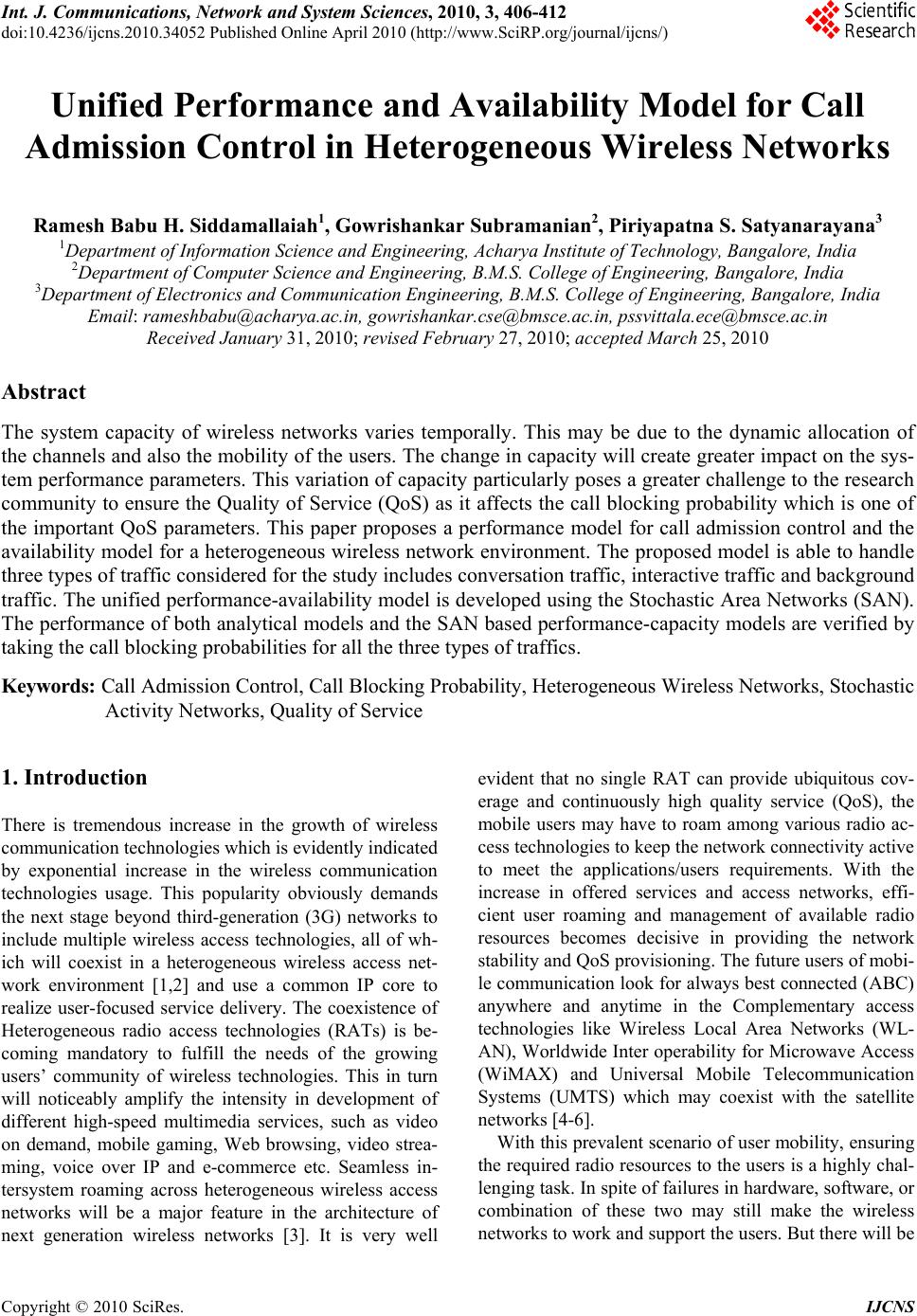 Int. J. Communications, Network and System Sciences, 2010, 3, 406-412 doi:10.4236/ijcns.2010.34052 blished Online April 2010 (http://www.SciRP.org/journal/ijcns/) Copyright © 2010 SciRes. IJCNS Pu Unified Performance and Availability Model for Call Admission Control in Heterogeneous Wireless Networks Ramesh Babu H. Siddamallaiah1, Gowrishankar Subramanian2, Piriyapatna S. Satyanarayana3 1Department of Information Science and Engineering, Acharya Institute of Technology, Bangalore, India 2Department of Computer Science and Engineering, B.M.S. College of Engineering, Bangalore, India 3Department of Electronics and Communication Engineering, B.M.S. College of Engineering, Bangalore, India Email: rameshbabu@acharya.ac.in, gowrishankar.cse@bmsce.ac.in, pssvittala.ece@bmsce.ac.in Received January 31, 2010; revised February 27, 2010; accepted March 25, 2010 Abstract The system capacity of wireless networks varies temporally. This may be due to the dynamic allocation of the channels and also the mobility of the users. The change in capacity will create greater impact on the sys- tem performance parameters. This variation of capacity particularly poses a greater challenge to the research community to ensure the Quality of Service (QoS) as it affects the call blocking probability which is one of the important QoS parameters. This paper proposes a performance model for call admission control and the availability model for a heterogeneous wireless network environment. The proposed model is able to handle three types of traffic considered for the study includes conversation traffic, interactive traffic and background traffic. The unified performance-availability model is developed using the Stochastic Area Networks (SAN). The performance of both analytical models and the SAN based performance-capacity models are verified by taking the call blocking probabilities for all the three types of traffics. Keywords: Call Admission Control, Call Blocking Probability, Heterogeneous Wireless Networks, Stochastic Activity Networks, Quality of Service 1. Introduction There is tremendous increase in the growth of wireless communication technologies which is evidently indicated by exponential increase in the wireless communication technologies usage. This popularity obviously demands the next stage beyond third-generation (3G) networks to include multiple wireless access technologies, all of wh- ich will coexist in a heterogeneous wireless access net- work environment [1,2] and use a common IP core to realize user-focused service delivery. The coexistence of Heterogeneous radio access technologies (RATs) is be- coming mandatory to fulfill the needs of the growing users’ community of wireless technologies. This in turn will noticeably amplify the intensity in development of different high-speed multimedia services, such as video on demand, mobile gaming, Web browsing, video strea- ming, voice over IP and e-commerce etc. Seamless in- tersystem roaming across heterogeneous wireless access networks will be a major feature in the architecture of next generation wireless networks [3]. It is very well evident that no single RAT can provide ubiquitous cov- erage and continuously high quality service (QoS), the mobile users may have to roam among various radio ac- cess technologies to keep the network connectivity active to meet the applications/users requirements. With the increase in offered services and access networks, effi- cient user roaming and management of available radio resources becomes decisive in providing the network stability and QoS provisioning. The future users of mobi- le communication look for always best connected (ABC) anywhere and anytime in the Complementary access technologies like Wireless Local Area Networks (WL- AN), Worldwide Inter operability for Microwave Access (WiMAX) and Universal Mobile Telecommunication Systems (UMTS) which may coexist with the satellite networks [4-6]. With this prevalent scenario of user mobility, ensuring the required radio resources to the users is a highly chal- lenging task. In spite of failures in hardware, software, or combination of these two may still make the wireless networks to work and support the users. But there will be  R. B. H. SIDDAMALLAIAH ET AL. 407 a definite effect on the system capacity, i.e., the number of channels available and number of users that can be accommodated by the wireless networks may decrease and the throughput of the system will come down. This is an important aspect concerned to performance modelling. There is a strong need of performance modelling which should be able to take care of not only the pure perform- ance but also the availability and reliability model of the system. But most of the performance models will con- sider this contention and generally over estimate the sit- uation and will not consider the failure–recovery of the systems resources in turn the traditional availability mo- dels are not considering the performance metrics. There is a need for a composite model which will work on fail- ure recovery model. Researchers have achieved success in developing tech- niques for modelling the performance, availability and reliability of communication systems in a unified way. There are good number of approaches that have proved the need of unified performance model and availability models of any stochastic system under study. In this pa- per we have proposed composite Performance and Avai- lability models and are evaluated using the stochastic petrinet. The further sections of the paper are organized as fol- lows. The Section 2 presents the performance model for call admission control. Section 3 focuses on the Avail- ability model. The Section 4 represents SAN based per- formance-availability of the CAC system and Section 5 is devoted to discuss the simulation results and Section 6 concludes the paper. 2. Performance Model In this paper we propose a novel analytic performance model admission control mechanism for reducing the call blocking probability there by increasing the resource utilization. This would achieve the objective of guaran- teeing the user QoS requirements. The proposed model is able to handle three types of traffic considered for the study includes conversation traffic, interactive traffic and background traffic. All of this traffic represents different QoS service class of traffic with the following QoS pa- rameters. The conversational traffic is sensitive to transfer delay and jitter. It demands guaranteed bit rate and low bit er- ror rate. The examples of the applications belonging to this category are video-conferencing and audio confer- encing. The interactive traffic is a QoS class that is not sensitive to transfer delay and Jitter but demands low bit error rate. The applications of this QoS class do not need guaranteed bit rate for example web browsing, interac- tive chats and interactive games. The background traffic QoS class is not sensitive to transfer delay and jitter but needs low bit error rate from the network and these ap- plications do not depend on guaranteed bit rate. The ex- amples belonging to this group are e-mail, SMS applica- tions. The assumption made for the design and develop- ment of analytical CAC model was type3 traffic would require three channels to be assigned in the system and type2 traffic demands two channels and type1 traffic needs one channel. The proposed model is developed keeping in mind the WCDMA, WiFi, and WiMax. The CAC mechanism proposed is focused only on the system’s ability to ac- commodate newly arriving users in terms of the total channel capacity which is needed for all terminals after the inclusion of the new user. In the case when the chan- nel load with the admission of a new call was precom- piled (or computed online) to be higher than the capacity of the channel the new call is rejected, if not, the new call could be admitted. The decision of admitting or re- jecting a new call in the network will be made only based on the capacity needed to accommodate the call. We consider a heterogeneous network which com- prises a set of RATs Rn with co-located cells in which radio resources are jointly managed. Cellular networks such as Wireless LAN and Wi-Max can have the same and fully overlapped coverage, which is technically fea- sible, and may also save installation cost. H is given as H {RAT 1, RA T 2, RAT k} where k is the total number of RATs in the heterogeneous cellular network. The het- erogeneous cellular network supports n-classes of calls, and each RAT in set H is optimized to support certain classes of calls. The analytical model for call admission control mec- hanism in heterogeneous wireless networks is modelled using higher order Markov model and is as shown in Figure 1. In the proposed model it is assumed that, whenever a new user enters the network will originate the network request at the rate λi and is assumed to fol- low a poisson process. The service time of the different class of traffic and types of calls is µi .The mean service time of all types of users were assumed to follow nega- tive exponential distribution with the mean rate 1/µ. Since voice traffic is Erlang distributed, the condition that is considered for simulation is negative exponential distribution. The total number of virtual channels in the system are N. When the numbers of available channels are below the specified threshold the system will drop the calls. The threshold limit is determined by three posi- tive integers A1, A2 and A3. These are called as utilization rates, where A is represented as Figure 1. Analytical model for CAC. C opyright © 2010 SciRes. IJCNS 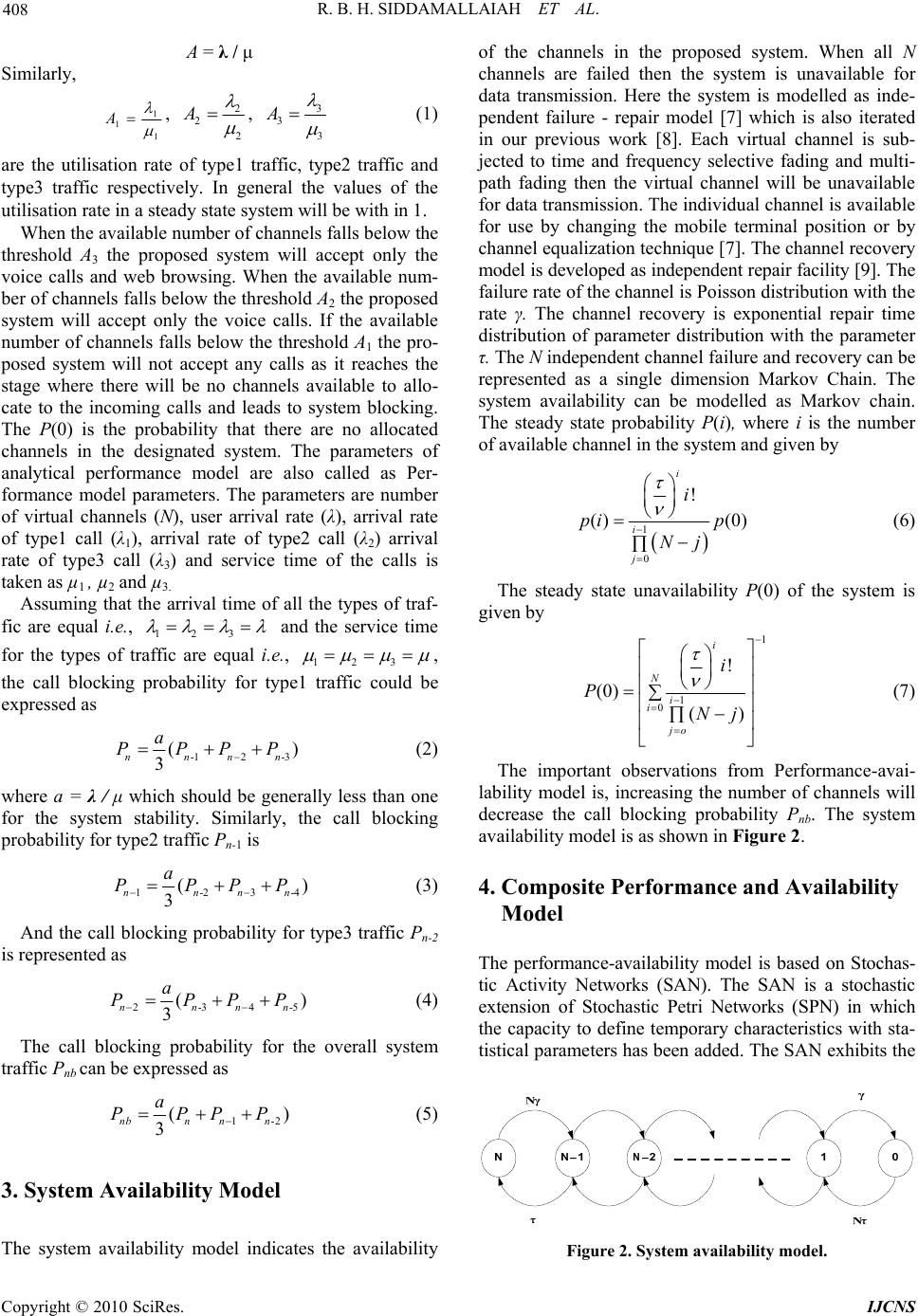 R. B. H. SIDDAMALLAIAH ET AL. 408 A = λ / μ Similarly, 1 1 1 A , 2 2 2 A , 3 3 3 A (1) are the utilisation rate of type1 traffic, type2 traffic and type3 traffic respectively. In general the values of the utilisation rate in a steady state system will be with in 1. When the available number of channels falls below the threshold A3 the proposed system will accept only the voice calls and web browsing. When the available num- ber of channels falls below the threshold A2 the proposed system will accept only the voice calls. If the available number of channels falls below the threshold A1 the pro- posed system will not accept any calls as it reaches the stage where there will be no channels available to allo- cate to the incoming calls and leads to system blocking. The P(0) is the probability that there are no allocated channels in the designated system. The parameters of analytical performance model are also called as Per- formance model parameters. The parameters are number of virtual channels (N), user arrival rate (λ), arrival rate of type1 call (λ1), arrival rate of type2 call (λ2) arrival rate of type3 call (λ3) and service time of the calls is taken as µ1 , µ2 and µ3. Assuming that the arrival time of all the types of traf- fic are equal i.e., 123 and the service time for the types of traffic are equal i.e., 123 , the call blocking probability for type1 traffic could be expressed as -12 -3 ( 3 nnnn a PPPP ) (2) where a = λ / μ which should be generally less than one for the system stability. Similarly, the call blocking probability for type2 traffic Pn-1 is 1-23 ( 3 nnn a PPPP -4 ) n (3) And the call blocking probability for type3 traffic Pn-2 is represented as 2-34 ( 3 nnn a PPPP -5 ) n (4) The call blocking probability for the overall system traffic Pnb can be expressed as 1-2 ( 3 nbn nn a PPPP ) (5) 3. System Availability Model The system availability model indicates the availability of the channels in the proposed system. When all N channels are failed then the system is unavailable for data transmission. Here the system is modelled as inde- pendent failure - repair model [7] which is also iterated in our previous work [8]. Each virtual channel is sub- jected to time and frequency selective fading and multi- path fading then the virtual channel will be unavailable for data transmission. The individual channel is available for use by changing the mobile terminal position or by channel equalization technique [7]. The channel recovery model is developed as independent repair facility [9]. The failure rate of the channel is Poisson distribution with the rate γ. The channel recovery is exponential repair time distribution of parameter distribution with the parameter τ. The N independent channel failure and recovery can be represented as a single dimension Markov Chain. The system availability can be modelled as Markov chain. The steady state probability P(i), where i is the number of available channel in the system and given by 1 0 ! () (0) i i j i pi p Nj (6) The steady state unavailability P(0) of the system is given by 1 1 0 ! (0) () i N i i jo i P Nj (7) The important observations from Performance-avai- lability model is, increasing the number of channels will decrease the call blocking probability Pnb. The system availability model is as shown in Figure 2. 4. Composite Performance and Availability Model The performance-availability model is based on Stochas- tic Activity Networks (SAN). The SAN is a stochastic extension of Stochastic Petri Networks (SPN) in which the capacity to define temporary characteristics with sta- tistical parameters has been added. The SAN exhibits the Figure 2. System availability model. Copyright © 2010 SciRes. IJCNS 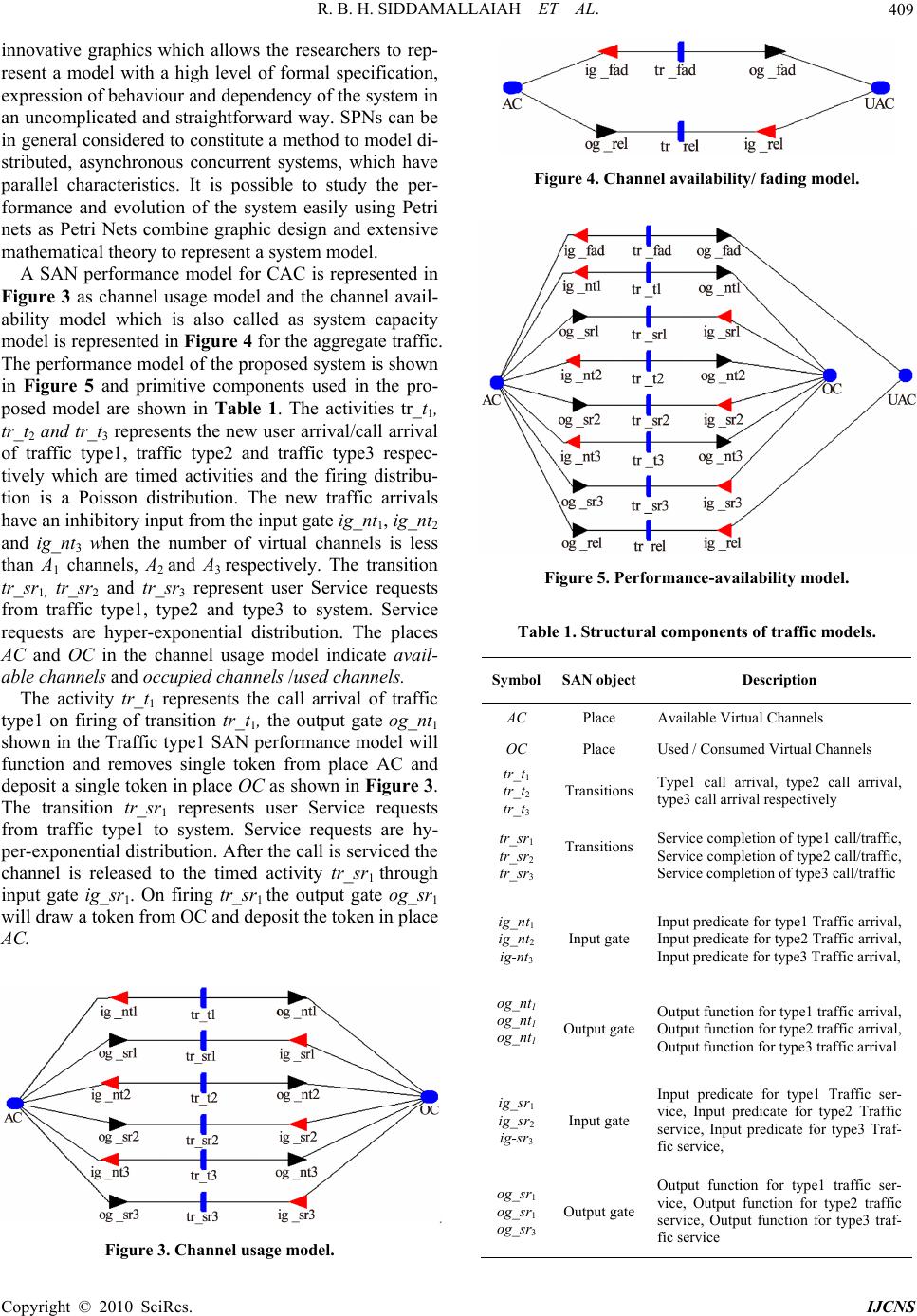 R. B. H. SIDDAMALLAIAH ET AL. 409 innovative graphics which allows the researchers to rep- resent a model with a high level of formal specification, expression of behaviour and dependency of the system in an uncomplicated and straightforward way. SPNs can be in general considered to constitute a method to model di- stributed, asynchronous concurrent systems, which have parallel characteristics. It is possible to study the per- formance and evolution of the system easily using Petri nets as Petri Nets combine graphic design and extensive mathematical theory to represent a system model. A SAN performance model for CAC is represented in Figure 3 as channel usage model and the channel avail- ability model which is also called as system capacity model is represented in Figure 4 for the aggregate traffic. The performance model of the proposed system is shown in Figure 5 and primitive components used in the pro- posed model are shown in Table 1. The activities tr_t1, tr_t2 and tr_t3 represents the new user arrival/call arrival of traffic type1, traffic type2 and traffic type3 respec- tively which are timed activities and the firing distribu- tion is a Poisson distribution. The new traffic arrivals have an inhibitory input from the input gate ig_nt1, ig_nt2 and ig_nt3 when the number of virtual channels is less than A1 channels, A 2 and A3 respectively. The transition tr_sr1, tr_sr2 and tr_sr3 represent user Service requests from traffic type1, type2 and type3 to system. Service requests are hyper-exponential distribution. The places AC and OC in the channel usage model indicate avail- able channels and occupied channels /used channels. The activity tr_t1 represents the call arrival of traffic type1 on firing of transition tr_t1, the output gate og_nt1 shown in the Traffic type1 SAN performance model will function and removes single token from place AC and deposit a single token in place OC as shown in Figure 3. The transition tr_sr1 represents user Service requests from traffic type1 to system. Service requests are hy- per-exponential distribution. After the call is serviced the channel is released to the timed activity tr_sr1 through input gate ig_sr1. On firing tr_sr1 the output gate og_sr1 will draw a token from OC and deposit the token in place AC. Figure 3. Channel usage model. Figure 4. Channel availability/ fading model. Figure 5. Performance-availability model. Table 1. Structural components of traffic models. SymbolSAN objectDescription AC Place Available Virtual Channels OC Place Used / Consumed Virtual Channels tr_t1 tr_t2 tr_t3 Transitions Type1 call arrival, type2 call arrival, type3 call arrival respectively tr_sr1 tr_sr2 tr_sr3 Transitions Service completion of type1 call/traffic, Service completion of type2 call/traffic, Service completion of type3 call/traffic ig_nt1 ig_nt2 ig-nt3 Input gate Input predicate for type1 Traffic arrival, Input predicate for type2 Traffic arrival, Input predicate for type3 Traffic arrival, og_nt1 og_nt1 og_nt1 Output gate Output function for type1 traffic arrival, Output function for type2 traffic arrival, Output function for type3 traffic arrival ig_sr1 ig_sr2 ig-sr3 Input gate Input predicate for type1 Traffic ser- vice, Input predicate for type2 Traffic service, Input predicate for type3 Traf- fic service, og_sr1 og_sr1 og_sr3 Output gate Output function for type1 traffic ser- vice, Output function for type2 traffic service, Output function for type3 traf- fic service C opyright © 2010 SciRes. IJCNS 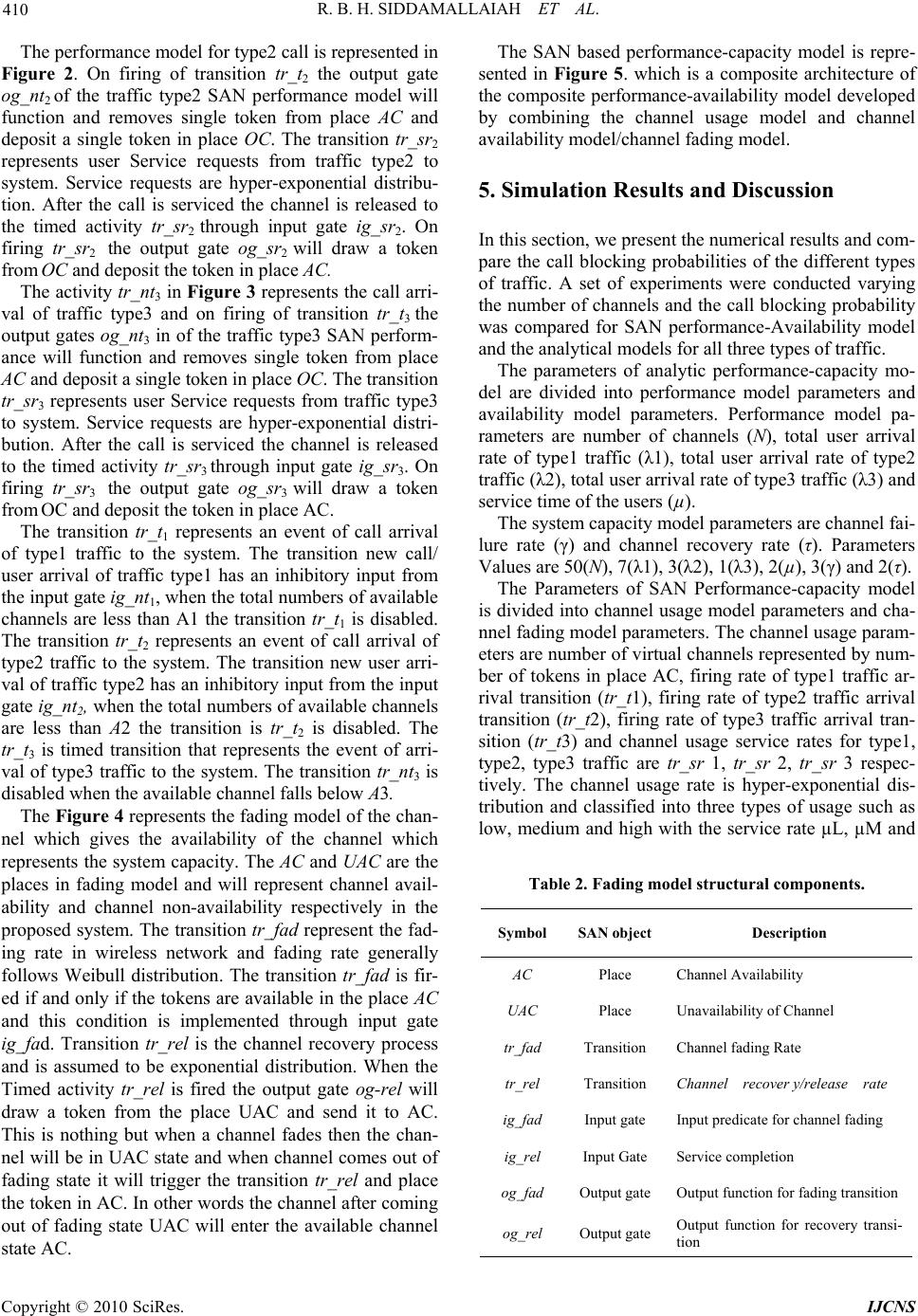 R. B. H. SIDDAMALLAIAH ET AL. 410 The performance model for type2 call is represented in Figure 2. On firing of transition tr_t2 the output gate og_nt2 of the traffic type2 SAN performance model will function and removes single token from place AC and deposit a single token in place OC. The transition tr_sr 2 represents user Service requests from traffic type2 to system. Service requests are hyper-exponential distribu- tion. After the call is serviced the channel is released to the timed activity tr_sr2 through input gate ig_sr 2. On firing tr_sr2 the output gate og_sr2 will draw a token from OC and deposit the token in place AC. The activity tr_nt3 in Figure 3 represents the call arri- val of traffic type3 and on firing of transition tr_t3 the output gates og_nt3 in of the traffic type3 SAN perform- ance will function and removes single token from place AC and deposit a single token in place OC. The transition tr_sr3 represents user Service requests from traffic type3 to system. Service requests are hyper-exponential distri- bution. After the call is serviced the channel is released to the timed activity tr_sr3 through input gate ig_sr3. On firing tr_sr3 the output gate og_sr3 will draw a token from OC and deposit the token in place AC. The transition tr_t1 represents an event of call arrival of type1 traffic to the system. The transition new call/ user arrival of traffic type1 has an inhibitory input from the input gate ig_ nt 1, when the total numbers of available channels are less than A1 the transition tr_t1 is disabled. The transition tr_t2 represents an event of call arrival of type2 traffic to the system. The transition new user arri- val of traffic type2 has an inhibitory input from the input gate ig_nt2, when the total numbers of available channels are less than A2 the transition is tr_t2 is disabled. The tr_t3 is timed transition that represents the event of arri- val of type3 traffic to the system. The transition tr_nt3 is disabled when the available channel falls below A3. The Figure 4 represents the fading model of the chan- nel which gives the availability of the channel which represents the system capacity. The AC and UAC are the places in fading model and will represent channel avail- ability and channel non-availability respectively in the proposed system. The transition tr_fad represent the fad- ing rate in wireless network and fading rate generally follows Weibull distribution. The transition tr_ fad is fir- ed if and only if the tokens are available in the place AC and this condition is implemented through input gate ig_fad. Transition tr_rel is the channel recovery process and is assumed to be exponential distribution. When the Timed activity tr_rel is fired the output gate og-rel will draw a token from the place UAC and send it to AC. This is nothing but when a channel fades then the chan- nel will be in UAC state and when channel comes out of fading state it will trigger the transition tr_rel and place the token in AC. In other words the channel after coming out of fading state UAC will enter the available channel state AC. The SAN based performance-capacity model is repre- sented in Figure 5. which is a composite architecture of the composite performance-availability model developed by combining the channel usage model and channel availability model/channel fading model. 5. Simulation Results and Discussion In this section, we present the numerical results and com- pare the call blocking probabilities of the different types of traffic. A set of experiments were conducted varying the number of channels and the call blocking probability was compared for SAN performance-Availability model and the analytical models for all three types of traffic. The parameters of analytic performance-capacity mo- del are divided into performance model parameters and availability model parameters. Performance model pa- rameters are number of channels (N), total user arrival rate of type1 traffic (λ1), total user arrival rate of type2 traffic (λ2), total user arrival rate of type3 traffic (λ3) and service time of the users (µ). The system capacity model parameters are channel fai- lure rate (γ) and channel recovery rate (τ). Parameters Values are 50(N), 7(λ1), 3(λ2), 1(λ3), 2(µ), 3(γ) and 2(τ). The Parameters of SAN Performance-capacity model is divided into channel usage model parameters and cha- nnel fading model parameters. The channel usage param- eters are number of virtual channels represented by num- ber of tokens in place AC, firing rate of type1 traffic ar- rival transition (tr_t1), firing rate of type2 traffic arrival transition (tr_t2), firing rate of type3 traffic arrival tran- sition (tr_t3) and channel usage service rates for type1, type2, type3 traffic are tr_sr 1, tr_sr 2, tr_ sr 3 respec- tively. The channel usage rate is hyper-exponential dis- tribution and classified into three types of usage such as low, medium and high with the service rate µL, µM and Table 2. Fading model structural components. Symbol SAN objectDescription AC Place Channel Availability UAC Place Unavailability of Channel tr_fad Transition Channel fading Rate tr_rel Transition Channel recover y/release rate ig_fad Input gate Input predicate for channel fading ig_rel Input Gate Service completion og_fad Output gate Output function for fading transition og_rel Output gate Output function for recovery transi- tion Copyright © 2010 SciRes. IJCNS 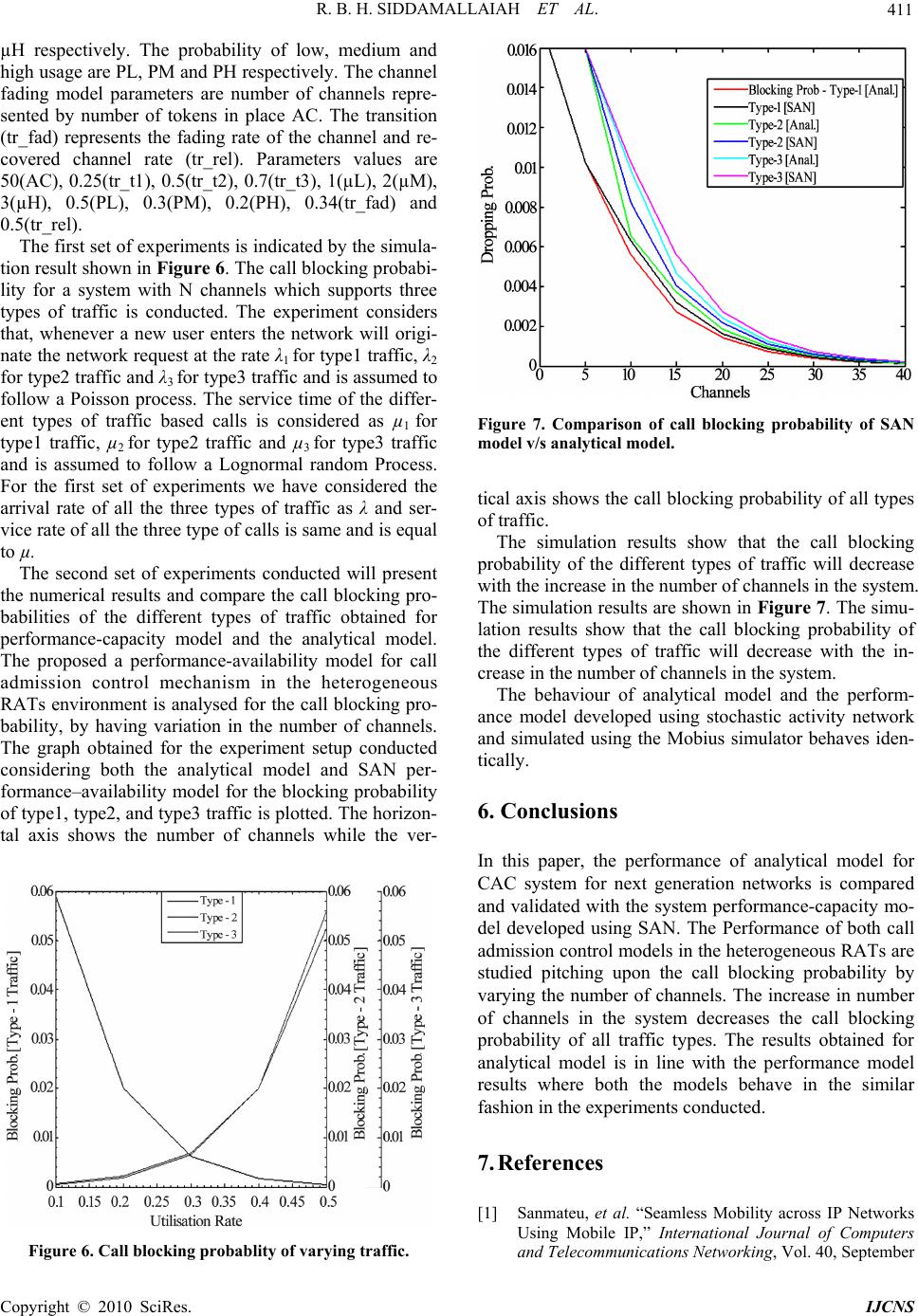 R. B. H. SIDDAMALLAIAH ET AL. 411 µH respectively. The probability of low, medium and high usage are PL, PM and PH respectively. The channel fading model parameters are number of channels repre- sented by number of tokens in place AC. The transition (tr_fad) represents the fading rate of the channel and re- covered channel rate (tr_rel). Parameters values are 50(AC), 0.25(tr_t1), 0.5(tr_t2), 0.7(tr_t3), 1(µL), 2(µM), 3(µH), 0.5(PL), 0.3(PM), 0.2(PH), 0.34(tr_fad) and 0.5(tr_rel). The first set of experiments is indicated by the simula- tion result shown in Figure 6. The call blocking probabi- lity for a system with N channels which supports three types of traffic is conducted. The experiment considers that, whenever a new user enters the network will origi- nate the network request at the rate λ1 for type1 traffic, λ2 for type2 traffic and λ3 for type3 traffic and is assumed to follow a Poisson process. The service time of the differ- ent types of traffic based calls is considered as µ1 for type1 traffic, µ2 for type2 traffic and µ3 for type3 traffic and is assumed to follow a Lognormal random Process. For the first set of experiments we have considered the arrival rate of all the three types of traffic as λ and ser- vice rate of all the three type of calls is same and is equal to µ. The second set of experiments conducted will present the numerical results and compare the call blocking pro- babilities of the different types of traffic obtained for performance-capacity model and the analytical model. The proposed a performance-availability model for call admission control mechanism in the heterogeneous RATs environment is analysed for the call blocking pro- bability, by having variation in the number of channels. The graph obtained for the experiment setup conducted considering both the analytical model and SAN per- formance–availability model for the blocking probability of type1, type2, and type3 traffic is plotted. The horizon- tal axis shows the number of channels while the ver- Figure 6. Call blocking probablity of varying traffic. Figure 7. Comparison of call blocking probability of SAN model v/s analytical model. tical axis shows the call blocking probability of all types of traffic. The simulation results show that the call blocking probability of the different types of traffic will decrease with the increase in the number of channels in the system. The simulation results are shown in Figure 7. The simu- lation results show that the call blocking probability of the different types of traffic will decrease with the in- crease in the number of channels in the system. The behaviour of analytical model and the perform- ance model developed using stochastic activity network and simulated using the Mobius simulator behaves iden- tically. 6. Conclusions In this paper, the performance of analytical model for CAC system for next generation networks is compared and validated with the system performance-capacity mo- del developed using SAN. The Performance of both call admission control models in the heterogeneous RATs are studied pitching upon the call blocking probability by varying the number of channels. The increase in number of channels in the system decreases the call blocking probability of all traffic types. The results obtained for analytical model is in line with the performance model results where both the models behave in the similar fashion in the experiments conducted. 7. References [1] Sanmateu, et al. “Seamless Mobility across IP Networks Using Mobile IP,” International Journal of Computers and Telecommunications Networking, Vol. 40, September C opyright © 2010 SciRes. IJCNS  R. B. H. SIDDAMALLAIAH ET AL. Copyright © 2010 SciRes. IJCNS 412 2002, pp. 181-190. [2] G. Wu, et al. “MIRAI Architecture for Heterogeneous Networks,” IEEE Communications, Vol. 40, No. 2, 2002, pp. 126-134. [3] S. Y. Hui and K. H. Yeung, “Challenges in the Migration to 4G Mobile Systems,” IEEE Communications, Vol. 41, No. 12, 2003, pp. 54-59. [4] X. G. Wang, J. E. Mellor and G. Min, “A QoS-Based Bandwidth Management Scheme in Heterogeneous Wire- less Networks,” International Journal of Simulation Sys- tems, Science and Technology, Vol. 5, No. 1-2, 2004, pp. 9-17. [5] E. Vanem, S. Svaet and F. Paint, “Effects of Multiple Access Alternatives in Heterogeneous Wireless Net- works,” IEEE Wireless and Networking, Vol. 3, 2003, pp. 1696-1700. [6] K. Murray, R. Mathur and D. Pesch, “Network Access and Handover Control in Heterogeneous Wireless Net- works for Smart Space Environments,” First Interna- tional Workshop on Management of Ubiquitous Commu- nications and Services, MUCS ,Waterford, Ireland, De- cember 11, 2003. [7] Gowrishankar, H. S. R. Babu, G. T. Raju and P. S. Sat- yanarayana, “Performability Model of Vertical Handoff in Wireless Data Networks,” 4th IEEE International Con- ference on Wireless and Mobile Communication (ICW- MC2008), Athens, Greece, 27 July-1 August 2008, pp. 309-314. [8] K. S. Trevedi, “Probability and Statistics with Reliability, Queuing and Computer Science Application,” 2nd Edi- tion, John Wiley and Sons, New York, 2001. [9] Mulgrw, “Applying Radial Basis Functions,” IEEE Signal Processing Magazine, Vol. 13, No. 2, 1996, pp. 50-65. |

